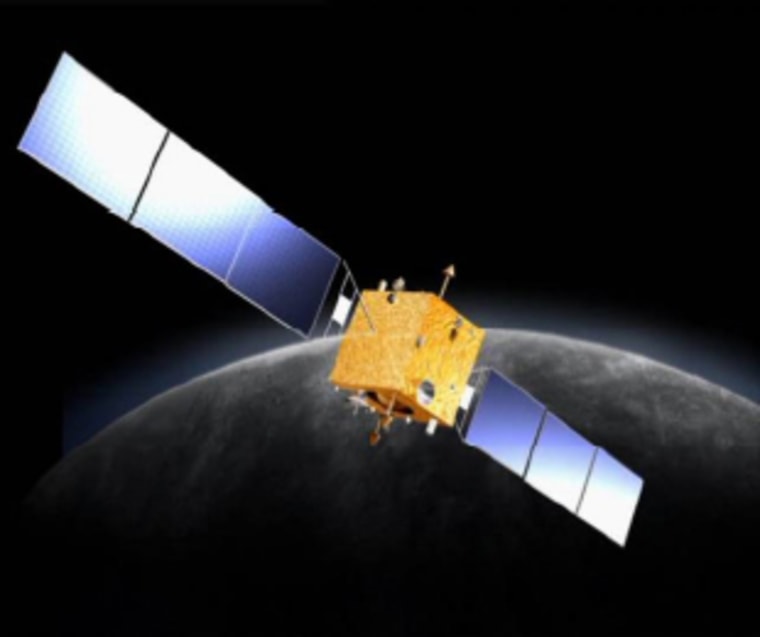China is ramping up for the launch this year of Chang’e 1, a lunar orbiter designed to set the stage for the nation’s future moon-bound missions.
Assembly of the China National Space Administration (CNSA) moon probe is complete, with tests underway of its rocket booster, according to several state media reports
“If everything goes well, the Chang’e 1 orbiter is expected to be launched in 2007,” a mission overview, one of several attributed to Luan Enjie, chief commander of the China Lunar Exploration Program (CLEP), stated. The multiple mission descriptions are listed on the CNSA’s lunar program website.
Chang’e 1 is slated to launch atop China’s Long March 3A rocket from the Xichang Satellite Launch Center in the nation’s southwestern province of Sichuan, though no official flight date has been given. The mission is named after a Chinese goddess who, in a popular fairy tale, lives on the moon.
Past reports in China’s official state media pointed to a planned April liftoff. But recent statements – such as a March 6 report by the Xinhua News Agency citing Huan Chunping, China’s chief consultant for its manned launch vehicle program – indicated the mission may be pushed to the latter half of 2007.
Huan was quoted by Xinhua as stating that China could ultimately succeed the Chang’e-1 flight with a manned mission the moon in 15 years (by 2022), though such an effort depends on the steady development of the nation’s Long March 5 heavy-lift rocket.
Studying the moon
Chang’e 1 is based on China’s Dongfanghong 3 telecommunication satellite platform and reportedly carries a 280-pound (127-kilogram) payload of science instruments for its planned one-year mission.
“In terms of technical configuration, Chang’e 1 is actually a new spacecraft,” Luan wrote in the CLEP mission overviews.
Luan stated that Chang’e 1 carries a total of eight primary instruments to photograph and map the lunar surface, probe its depth, study the regolith’s chemical composition, and analyze the space environment around the moon.
According to the mission description, Chang’1 carries two basic imagers.
Slideshow 12 photos
Month in Space: January 2014
A CCD stereo camera will produce three-dimensional images of the lunar surface by compiling three separate, two-dimensional views of each target area. Meanwhile, the probe’s interferometer spectrometer imager is expected to overlay optical measurements with spectra to depict the regional distribution of resources and materials, Luan added.
Chang’e 1 will also carry a laser altimeter to take precise elevation measurements of the lunar surface, as well as gamma/X-ray spectrometers to hunt out and measure the amount of up to 14 elements – among them iron, potassium, uranium and titanium — according to Luan’s description.
A microwave detector will bounce signals down to the moon’s surface, operating on four different frequencies to determine the lunar regolith’s depth, while a high-energy solar particle detector and low-energy ion instrument — Chang’e 1’s space environment monitor system —measures the solar wind environment, according to the CNSA mission description.
A payload data management system rounds out Chang’e 1’s instrument package. Also riding to the moon aboard the lunar probe are some 30 songs, among them Chinese folk songs and “The East is Red” – China’s national anthem – Xinhua reported in November.
In the past, Luan has told the People’s Daily Onlinethat Chang’e 1 carries an overall mission cost of 1.4 billion yuan (about $180 million).
The lunar path
CNSA officials stated that Chang’e 1 is destined to circle the moon in a polar orbit at an altitude of between 62 and 124 miles (100 and 200 kilometers).
“Considering the abnormality of the lunar gravity field, Chang’e 1 may fall on the lunar surface within half a year if a 100 [kilometer] orbit is selected,” Luan stated, adding that a 200-kilometer orbit will be chosen if mission managers decide not to probe the moon’s gravitational field.
To reach the moon in the first place, Chang’e 1 is expected to launch spaceward into a highly elliptical orbit that comes within 372 miles (600 kilometers) of Earth at its closest point, according to the mission overview. Its flight plan then calls for a series of three maneuvers to gradually climb into ever-higher orbits for the eventual departure for the moon.
“Lunar acquisition is the most essential point in the orbit design in Chang’e Program,” Luan stated. “If lunar acquisition is not designed perfectly, the satellite will fly by or impact the moon, which may lead to grave consequence.”
Beyond Chang’e 1
The Chang’e-1 mission is reportedly the first of China’s three-phase plan for lunar exploration, which includes a follow-up lunar lander or rover by 2012, and an ultimate sample return flight in 2017, according to past press reports.
China is the third nation to build and launch spacecraft to ferry astronauts into orbit following the former Soviet Union and United States. The country launched its first astronaut into space during the 2003 flight of Shenzhou 5, and followed with the two-astronaut Shenzhou 6 flight in October 2005.
A third manned spaceflight, Shenzhou 7, is slated for 2008 and expected to feature China’s first spacewalk, state media has reported.
Huang told Xinhua last week that engineers have completed designing the engines for China’s Long March 5 rocket, which is expected to be able to haul payloads of between nine and 25 tons into orbit when complete. Intended to launch a Chinese space station, the booster should be ready in about eight years, Huang told Xinhua.
Last month, state media reported that China formerly planned to build a new launch site on Hainan Island in the South China Sea, which some China space analysts have said would be required for any new heavy-lift boosters.
But a Chinese manned mission to the moon will require substantially stronger rockets than those currently available, Luan told the nation’s state media last week.
“[A] moon landing needs a rocket with 3,000 to 4,000 tons of thrust,” Xinhua quoted him as saying. “But the most power thrust carrier rocket is at around 600 tons."

